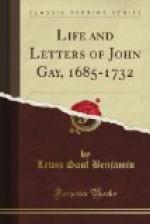Undismayed by the failure of his first play, “The Wife of Bath,” Gay made another bid for theatrical success with “The What D’ye Call It,” which was performed at Drury Lane Theatre in February, 1715, and published in March of that year. In the preface Gay wrote: “I have not called it a tragedy, comedy, pastoral, or farce, but left the name entirely undetermined in the doubtful appellation of ’The What D’ye Call It’ ... but I added to it ‘A Tragi-Comi-Pastoral Farce,’ as it contained all these several kinds of drama.” Pope saw the play and wrote about it to Congreve, March 19th, 1715: “The farce of ‘The What D’ye Call It’ has occasioned many different speculations in the town, some looking upon it as a mere jest upon the tragic poets, others as a satire upon the late war. Mr. Cromwell, hearing none of the words, and seeing the action to be tragical, was much astonished to find the audience laugh, and says the Prince and Princess [of Wales] must doubtless be under no less amazement on the same account. Several Templars and others of the more vociferous kind of critics went with a resolution to hiss, and confessed they were forced to laugh so much that they forgot the design they came with. The Court in general has come in a very particular manner into the jest, and the three nights, notwithstanding two of them were Court nights, were distinguished by very full audiences of the first quality. The common people of the pit and gallery received it at first with great gravity and sedateness, and some few with tears; but after the third day they also took the hint, and have ever since been very loud in their claps. There are still sober men who cannot be of the general opinion, but the laughers are so much the majority that one or two critics seemed determined to undeceive the town at their proper cost, by writing dissertations against it to encourage them in this laudable design. It is resolved a preface shall be prefixed to the farce, in vindication of the nature and dignity of this new way of writing."[1] The fact is that, as Johnson put it, “the images were comic and the action grave,” and there were many mock-heroic passages which parodied tragedies, including Addison’s “Cato” and Otway’s “Venice Preserved,” well-known in that day. Also it contained several ballads, of which perhaps the best is “’Twas when the seas were roaring” (Act II., Scene 8).
“The What D’ye Call It” was not a piece of much value, but it pleased the audience, and Gay was highly delighted. “Now my benefit night is over, it should be my first care to return my thanks to those to whom I am mostly obliged, and the civilities I have always received from you, and upon this occasion too, claims this acknowledgment,” the author wrote to Caryll on March 3rd: “‘The What D’ye Call It’ met with more success than could be expected from a thing so out of the common taste of the town. It has been played already five nights, and the galleries, who did not know at first what to make of it, now enter thoroughly into




